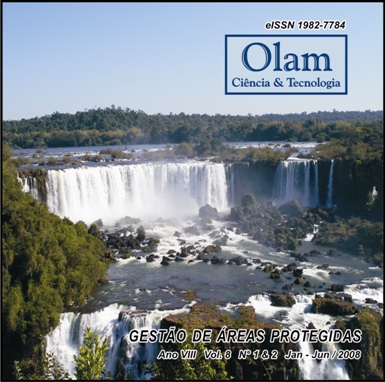O PENSAMENTO AMBIENTAL E AS MODALIDADES DE UNIDADES DE CONSERVAÇÃO NO AMAPÁ
Palavras-chave:
Preservação Ambiental. Unidades de Conservação. Amapá. Política Ambiental. Fronteira Setentrional. Território.Resumo
Partindo de uma análise histórica é possível observar a relação existente entre as concepções ideológicas, as correntes do pensamento ambiental e a modalidade de unidades de conservação criadas no decorrer dos tempos, no Brasil e no Amapá. Assim, se a matriz ideológica de determinado grupo se enquadra em pensamentos tendentes ao ecocêntrico, este militará pela criação de unidades de proteção integral. O presente artigo aborda implementação de unidades de conservação no Brasil e, em especial, no Estado do Amapá. Esta relação se faz particularmente em função de que há a defesa de uma das modalidades de unidades de conservação prevista na legislação ambiental, conforme a tendência de pensamento ambiental. A análise das unidades de conservação no Brasil, tanto sob o aspecto cronológico quanto sob o aspecto das modalidades atuais demonstra que há uma tendência atual a criação de unidades de uso sustentável, o contrário do que ocorria até 1984. No Amapá encontram-se unidades de conservação tanto localizadas nas categorias de proteção integral – o maior percentual, quanto as de uso sustentável. A estrutura deste texto está dividida em dois tópicos, ei-los. O primeiro tece algumas reflexões sobre a instalação de áreas protegidas no Brasil, destacando as correntes ideológicas que embasaram a forma de criação e gestão de áreas protegidas, bem como as funções que estas unidades devem desempenhar; os tipos de modalidades recentes de unidades de conservação no Brasil; debate a criação de unidades de conservação no Brasil e a sua relação com o Plano Amazônia Sustentável (PAS), a fim de relacionar a criação dessas Unidades com a ampla caracterização do território e a definição o seu uso, cujas práticas se apresentam com raras exceções na efetivação de unidades de conservação no pais. O segundo, desenha as unidades de conservação da natureza no Estado do Amapá, sua gênese, institucionalização e conflitos; destaca que embora numericamente a maior parte das UC’s terem sido criados ainda com o Amapá na condição de Território Federal, em extensão se protegeu mais enquanto Estado e que as maiores UC’s em extensão estão sob a tutela do Governo Federal; observa, também, que a expressiva porção do território amapaense como área protegida tem funcionado como fatores de expansão e restrição do território; analisa a expansão de áreas protegidas contíguas na faixa de fronteira setentrional: do lado brasileiro os ParNas do Tumucumaque e do Cabo Orange; do lado da Guiana Francesa, a criação do Parque Amazônico da Guiana. Palavras-chave: Preservação Ambiental. Unidades de Conservação. Amapá. Política Ambiental. Fronteira Setentrional. Território. Abstract From a historical analysis is possible to observe the existent relationship among the ideological conceptions, the environmental thought and the model of conservation units created during the years, in Brazil and in Amapá. This way, if the ideological pattern of such a group frames itself in tendency thoughts to the ecocentric, this will militate for the creation of units of full protection. The present article approaches the implementation of conservation units in Brazil and, especially, in the State of Amapá. This relationship is made particularly because there is the defense of one of the models of conservation units foreseen in the environmental legislation, according to the tendency of environmental thought. The analysis of the conservation units in Brazil, both under the chronological aspect and under the aspect of the current models show that there is a current tendency for the creation of units of sustainable use, the opposite of what happened up to 1984. In Amapá there are conservation units located in the categories of integral protection - the highest percentage, as the ones of sustainable use. The structure of this text is divided into two topics, as follow. The first brings some reflections about the installation of protected areas in Brazil, highlighting the ideological thought that darkened the creation frame and the management of protected areas, as well as the functions that these units should carry out; the types of recent models of conservation units in Brazil; it focuses on the creation of conservation units in Brazil and their relationship with the Sustainable Amazon Plan (PAS), in order to relate the creation of those Units with the wide characterization of the territory and the definition of its use, whose practices present themselves with rare exceptions in the effectiveness of conservation units in the nation. The second, designs the conservation units of the nature in the State of Amapá, its genesis, institutionalization and conflicts; highlights that although numerically the most of CU’s have still been created when Amapá was in the condition of Federal Territory, in extension it was more protected while State and that the largest CU's in extension are under the protection of the Federal Government; it also observes, that the expressive area of the amapaense territory as protected area has worked as expansion and restriction factors of the territory; it analyzes the expansion of contiguous protected areas in the strip of setentrional border: on the Brazilian side the ParNas of Tumucumaque and of the Cabo Orange; beside French Guiana, the creation of the Amazonian Park of Guyana. Key-words: Environmental Preservation. Conservation Units. Amapá. Environmental Politics. Setentrional Border. Territory. OLAM - Ciência & Tecnologia, Rio Claro, SP, Brasil – eISSN: 1982-7784 está licenciada sob Licença Creative Commons. Rio Claro / SP, Brasil Ano VIII Vol. 8 No.2, Janeiro - Junho / 2008 – RESUMOSDownloads
Publicado
17-08-2008
Como Citar
PORTO, J. L. R., CHELALA, C. A., & ANDRADE, E. B. de. (2008). O PENSAMENTO AMBIENTAL E AS MODALIDADES DE UNIDADES DE CONSERVAÇÃO NO AMAPÁ. OLAM: Ciência & Tecnologia, 8(2). Recuperado de https://www.periodicos.rc.biblioteca.unesp.br/index.php/olam/article/view/1494
Edição
Seção
ARTIGOS







